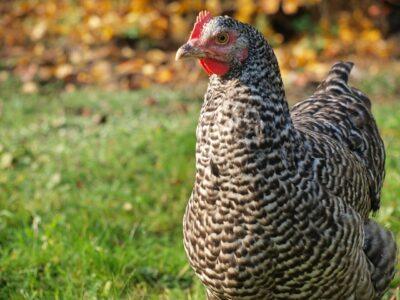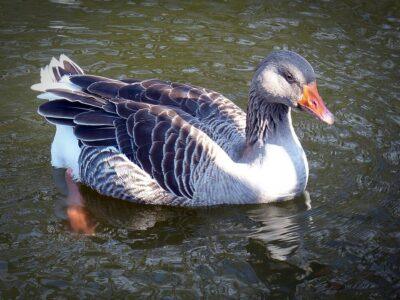For most homesteaders, having poultry is an important part of the lifestyle. We’ve all read the magazine articles about preserving our heritage poultry, and so we bring home flocks of gorgeous Rhode Island Reds and Welsh Harlequin ducks, trios of Royal Palm turkeys, and a pair or two of handsome Pilgrim Geese.
We enjoy our poultry flocks. After all, we are living like our forefathers, right? Well, maybe not.
What if I told you that most of the beautiful species of poultry we raise today weren’t even developed back when great-great granddaddy had his farm and worked the land?
For most of us, our great-great grandparents would have been living life in the 1800s. Whether your ancestors lived on farms or in town, pretty much everyone owned chickens. Dual-purpose chickens provided both eggs and meat, and for this reason most families of six had at least a dozen or more birds. Feeding your flock was mostly about free-ranging them in your yard and feeding them scraps. Occasionally, birds were supplemented with cracked corn, oats, barley or wheat.
Goose and duck flocks were managed in much the same way as chickens, and some breeds were developed to weed crops and orchards. Geese were raised for not only meat but also their feathers and down, which were used in pillows and mattresses. Duck owners enjoyed their meat as well as their eggs. Neither was widely raised until later in the century. In most areas of the country, ducks and geese were hunted rather than grown, most likely as a way to provide meat for the family without the time and expense of managing a flock. Duck meat has never really gained the popularity here that it has in Europe, due largely to the fact that chickens tend to be leaner and far more prolific.
Are Your Prepared For A Downed Grid? Get Backup Electricity Today!
For the farmer with larger fowl such as turkeys, the birds were primarily allowed to forage. Flocks were raised not only for meat, but also because of their remarkably large appetite for bugs. For this reason, they were often raised in orchards and in woodlots, where the birds also had space to roost in trees. During the winter, birds were supplemented with corn, oats, barley or wheat, much like chickens. Some old-timey turkey-raising manuals even suggest that farmers slaughter a hog as feed for their turkey flocks during the winter months as a way to provide extra fats and protein.
With turkeys being native to over half of the United States, there were plenty of small farms that preferred to hunt them rather than raise them. However, events such as the Mexican-American War and the Civil War impacted the wild populations of the Gould’s, Rio Grande and the Eastern Wild along the Southern United States.
The Breeds of Great-Great Grandaddy’s Day
Chickens
In the early 1800s, chickens were strictly viewed as a utilitarian bird. This meant that flocks largely consisted of crosses of the birds available at the time. One of the more common purebred birds was the Dominique, a dual-purpose bird with barred markings and a very good foraging ability. These handsome birds were often depicted in paintings from that era and are credited as being the oldest breed in America.
Immigrants to the New World brought along breeds such as the Hamburg and Polish, as well as crossed birds from their native countries. The Java also made its appearance in the early 1800s in the colors of black, white and mottled. From these birds of possible Asiatic descent, the Plymouth Rock was developed and made its first official appearance in 1835. English varieties such as the Dorking were imported into the United States around this same time, and by the 1850s “Hen Fever” had caught on to the point that even small farmers were venturing into new breeds. Some of these early imports included the Brahma, Cochin, Orpington, and later on, the Leghorn. By the end of the century many breeders, farmers and enthusiasts were tinkering with creating their own breeds, and we see the emergence of the Winnebago (modern-day Silver Laced Wyandotte), Jersey Giant, Buckeyes and Rhode Island Red.
For our ancestors, the importation and creation of new breeds created larger, often more robust animals that produced better meat and more eggs. Imports were expensive, and a common practice of those early days was to buy a rooster of imported blood and breed it into an established flock. Since hens were allowed to go broody and hatch their own chickens, it took a relatively short amount of time to completely change the landscape of chicken raising in the U.S.
Ducks
The first domesticated ducks in American are believed to have been the Aylesbury from England and the Huttegem from Belgium. While I could find very little about the Huttegem, the Aylesbury is still a very popular breed in England and is prized for its delicious meat and good egg laying ability. Both breeds were not uncommon in New England during the 1800s, and small farms throughout the Midwest usually had a combination of these breeds crossed with domesticated wild mallards.
In the early 1800s, several new duck breeds emerged, claiming to be bred from native species that were caught and domesticated. Most never gained popularity and they disappeared. One in particular endured — the Cayuga duck. The Cayuga’s wild beginnings are often disputed, however, with many believing it actually to be a descendant of the Lancashire Black, which was common on farms in Lancashire, England, into the 1860s. Regardless of its start, the Cayuga was named after the Cayuga region of New York, and the breed was popular in the North East due to its hardiness and its personable, easy nature.
As “Hen Fever” ramped up and chickens began to be imported, a few duck breeds also arrived. In 1850, the Rouen entered the U.S. by way of England, and small poultry keepers rushed to add these heavy weight ducks to their small flocks in an effort to increase meat yields.
The late 1800s saw the importation of the Blue Swedish Duck, and near the turn of the century the first Pekin (or Peking) White ducklings arrived. From here, the U.S. saw the development of many other duck breeds well into the 20th Century.
Geese
Domesticated geese came into America in the early days of the first European settlers. These birds were most likely descendants of the wild Greylag goose, and/or descendants of the domesticated Roman goose.
Beyond birds bred for the small farm or homestead, geese were being bred in large numbers to be used to weed the cotton fields of the South. Descended from unknown birds that arrived during colonial times, these birds became their own breed, the Cotton Patch. Regardless, in my research I could find no truly distinguished goose breeds listed until the arrival of the Bremens (the modern Embden) in the early 1800s. We do know that the Cotton Patch goose was already being utilized in the south by this time; they just hadn’t yet been developed into a true “breed.”
Following the Bremens, Toulouse arrived during the mid-century and became widely popular in the Midwest due to their heat tolerance. In the later part of the century we see the arrival of both the African and Chinese goose, which descend from the wild swan goose of Asia. While the Toulouse flourished in America, the Africans and Chinese didn’t really catch on until much, much later.
Turkeys
Domesticated turkeys in the Americas have an interesting history. The original turkey breed in America (domesticated) and most widely raised is the Bronze. These birds are descended from varieties brought by the first Europeans, crossed with the wild Eastern Turkeys. The resulting animals displayed Hybrid Vigor — being hardier, taller and much heavier than either. Stock from these crosses was retained and resulted in the breed we know today as the Heritage Bronze.
Sometime during the 1700s, the ancestors of the Norfolk Black (also called the Black Spanish) arrived. These birds descended from turkeys taken from Mexico to Europe in the 1500s and brought back to American with the early European Settlers. The birds were then crossed into wild Eastern Turkeys to make it what it is today. While they enjoyed popularity for a time, the breed had more or less fallen out of favor by the mid-1800s.
The Black was used in developing what some consider to be the first truly American turkey, the Narragansett. Developed in Rhode Island from wild Easterns and Blacks, they were considered THE turkey of choice from the Midwest to the Mid-Atlantic from the 1700s until their decline around 1900. They were the first breed to be bred and standardized for commercial production, and were popular on small farms and homesteads for their mild dispositions, large size and prolific breeding. Farmers raising these birds during the early 1800s claimed that a flock of a dozen hens could produce a flock of 100-200 birds in a single year!
Sometime right before the 1800s, the Chocolate turkey arrived from France. These birds were not quite as large or as cold-tolerant as the Northeastern breeds, but they became very popular in the Southern United States prior to the Civil War. They were a popular sight on small holdings and plantations alike, but with the desperate times of the war flocks were devastated to such a degree that they never really made a comeback.
About the same time that the Chocolate was arriving, a new breed was finding favor in the Northeast — the Holland White. It’s interesting to note that the Holland is not a Dutch bird as the name suggests, and is actually a mutant strain of the Heritage Bronze. They quickly found favor for being a bit smaller than the other breeds available at the time, and with their white pin feathers they quickly developed into a commercial breed. They were not as popular with small farmers and homesteaders as the other breeds.
In the late 1800s, the Bourbon Red (or “Bourbon Butternut,” as it was originally known) was developed, and if your ancestors lived in Kentucky or Ohio as mine did, this was the breed they raised. The striking red birds with white tail and wing feathers became very popular for their good growth and large size. They have remained popular into the 21st Century.
It’s worth mentioning that the Jersey Buff was also available during the 1800s, though its exact emergence is difficult to pin down. We do know that it was used in the development of the Bourbon Red, but truly never gained popularity and was considered to be extinct by 1915.
What is plain when researching these breeds is that our forefathers relied on poultry that could withstand the climate they were being raised in and reproduce effectively there. Birds that could serve multiple purposes were far more preferred than anything that was just merely pretty, and efficient foragers with good growth rates were a must. Our great-great grandparents simply didn’t have the time, money or energy to expend on stock that didn’t offer a good return.
What would you add? Do you know what types of breeds your ancestors raised? Share your thoughts in the section below:
 Off The Grid News Better Ideas For Off The Grid Living
Off The Grid News Better Ideas For Off The Grid Living






